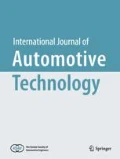Abstract
In this work, the development of a hybrid lightweight automotive chassis control arm is demonstrated. It includes the development of a new simulation method for designing metal — LFT (long fiber-reinforced thermoplastics) rehybrid parts and the new hybrid forming method for its manufacture. Beginning with the original geometry of a series steel chassis control arm, the design was optimized for the hybrid forming process where a steel sheet part is reinforced by an LFT rib structure, and both parts are joined by an LFT layer. For this purpose, a new FE optimization process chain was established. The thickness of the sheet metal and LFT layers, the geometry and thickness of the ribs of the hybrid control arm could be determined to meet both mechanical and light weight requirements. Afterwards, a suitable tooling concept and process for the hybrid forming were developed and tested. The forming behavior of two different steel grades along with an LFT was demonstrated and analyzed with the help of 3D measurement techniques and relevant section cuts. Finally, a weight reduction of nearly 20 % compared to the original component was realized with the hybrid forming process.
Similar content being viewed by others
References
Ahlers, M. (2016). Carbon Core-die neue BMW 7er Karosserie. Karosseriebautage Hamburg 2016–14, ATZ-Fachtagung, 125–135.
Al-Sheyyab, A. and Ehrenstein, G. W. (2006). Leichtmetall-Kunststoff-Hybride umformen und verbinden. Blech InForm, 5, 119–122.
Altair Engineering (2016). OptiStruct 14.0 Reference Guide.
Bergs, T., Schueler, M., Fang, X.F., Heidrich, D. and Herrig, T. (2019). Automotive hybrid design production and effective end machining by novel abrasive water jet technique. 2nd CIRP Conf. Composite Material Parts Manufacturing. Sheffield, UK.
Buerkle, E., Sieverding M. and Mitzler, J. (2003). Spritzgießverarbeitung von langfaserverstärktem PP. Kunststoffe. München, Germany.
Drebenstedt, C., Zopp, C., Hackert, C. and Kroll, L. (2018). Querlenker aus Hybrid-Aluminiumschaum-Sandwich. Lightweight Design 11, 2, 44–49.
Drossel, W. G., Albert, A. and Zorn, W. (2014). Active media based forming for the in situ manufacturing of metal and plastic composite structures. Euro Hybrid Materials and Structures, 152–9.
Drummer, D. (2015). Handbuch Kunststoff-Metall-Hybridtechnik. Lehrstuhl für Kunststofftechnik. Erlangen, Bavaria, Germany.
Ehrenstein, G. (2004). Handbuch Kunststoff-Verbindungstechnik. Carl Hanser Verlag. München, Germany.
Evonik. (2016). VESTAMELT® Hylink adhesion promoter, Technical information, Evonik Resource Efficiency GmbH. Marl, Germany.
Fang, X. and Kloska, T. (2019). Hybrid forming of sheet metals with long fiber-reinforced thermoplastics (LFT) by a combined deep drawing and compression molding process. Int. J. Material Forming 13, 4, 561–575.
Gies, S. (2010). Interview zum Einfluss des Elektroantriebs auf die Fahrdynamik. Automobiltechnische Zeitschrift. 06/2010, 400.
Henning, F., Kaerger, L., Doerr, D., Schirmaier, F. J., Seuffert, J. and Bernath, A. (2019). Fast processing and continuous simulation of automotive structural composite components. Composites Science and Technology, 171, 261–279.
Heidrich, D., Kloska, T. and Fang, X. (2020). Hybrid Forming — A novel manufacturing technique for metal-LFT structural parts. SAE International J. Advances and Current Practices in Mobility, 2, 3130–3139.
Hussain, M. M., Rauscher, B. and Tekkaya, A. E. (2008). Wirkmedienbasierte Herstellung hybrider MetallKunststoff-Verbundbauteile mit Kunststoffschmelzen als Druckmedium. Materialwissenschaft und Werkstofftechnik 39, 9, 627–632.
Kurtenbach, S., Schoentauf, G., Nevoigt, A. and Butakov, D. (2019). Capability of glass fiber reinforced plastics for lightweight design control arms in wheel suspension. 9th Int. Munich Chassis Symp. 2018, Springer Vieweg. Wiesbaden, Germany.
Modler, N., Adam, F. and Maass, J. (2015). Intrinsic lightweight steel-composite hybrids for structural components. Materials Science Forum, 825, 401–408.
Muhr, T., Weber, J., Theobald, A. and Hillebrecht, M. (2015). Wirtschaftliche Leichtbauweise für eine hybride B-säule, ATZ-Automobiltechnische Zeitschrift 117, 3, 6–21.
Rauscher, B. (2011). Formschlüssig verbundene Metall-Kunststoff-Hybridbauteile durch Integration von Blechumformung und Spritzgießen. Shaker Verlag. Aachen, Germany.
Salzgitter Flachstahl GmbH. (2020). https://www.salzgitter-flachstahl.de/fileadmin/footage/MEDIA/gesellschaften/szfg/infomationsmatmal/produktinformationen/warmhewalzte_produkte/deu/szbs800.pdf
Starke, J. (2016). Carbon composites in automotive structural applications. EuCIA: Composites and Sustainability.
Schild, J. (2017). Verfahrensentwicklung zur integrierten Herstellung von Kunststoff/Metall-Strukturbauteilen im Spritzgießverfahren. Verlag Mainz. Aachen, Germany.
Spancken, D., Bueter, A., Toews, P. and Schwarzhaupt, O. (2017). Prüfung und Bewertung eines funktionsintegrierten Leichtbauquerlenkers. Lightweight Design 10, 3, 32–35.
voestalpine AG. (2020). https://www.voestalpine.com/ultralights/Produkte/Warmumformung/phs-ultraform-R
Zhang, S. H. and Danckert, J. (1998). Development of hydro-mechanical deep drawing. J. Materials Processing Technology 83, 1–3, 14–25.
Acknowledgement
This research was supported by the Federal Ministry of Education and Research (BMBF) in the context of a project named “MultiForm” and supervised by the Project Management Agency Karlsruhe (PTKA) at the Karlsruhe Institute of Technology (KIT).
The authors thank all industry partners of this project for their support and cooperation, especially Mr. Gruhn, Mr. Heinritz, Dr. Kersten, Mr. Stoetzner, Mr. Sonnenstaedt, Mr. Sprick, and Mr. Welzel. The authors also thank the support of Mr. Bergs and Mr. Schueler for carrying out the waterjet cuttings.
Author information
Authors and Affiliations
Corresponding author
Additional information
Publisher’s Note
Springer Nature remains neutral with regard to jurisdictional claims in published maps and institutional affihations.
Rights and permissions
About this article
Cite this article
Kloska, T., Fang, X. Lightweight Chassis Components — The Development of a Hybrid Automotive Control Arm from Design to Manufacture. Int.J Automot. Technol. 22, 1245–1255 (2021). https://doi.org/10.1007/s12239-021-0109-0
Received:
Revised:
Accepted:
Published:
Issue Date:
DOI: https://doi.org/10.1007/s12239-021-0109-0




